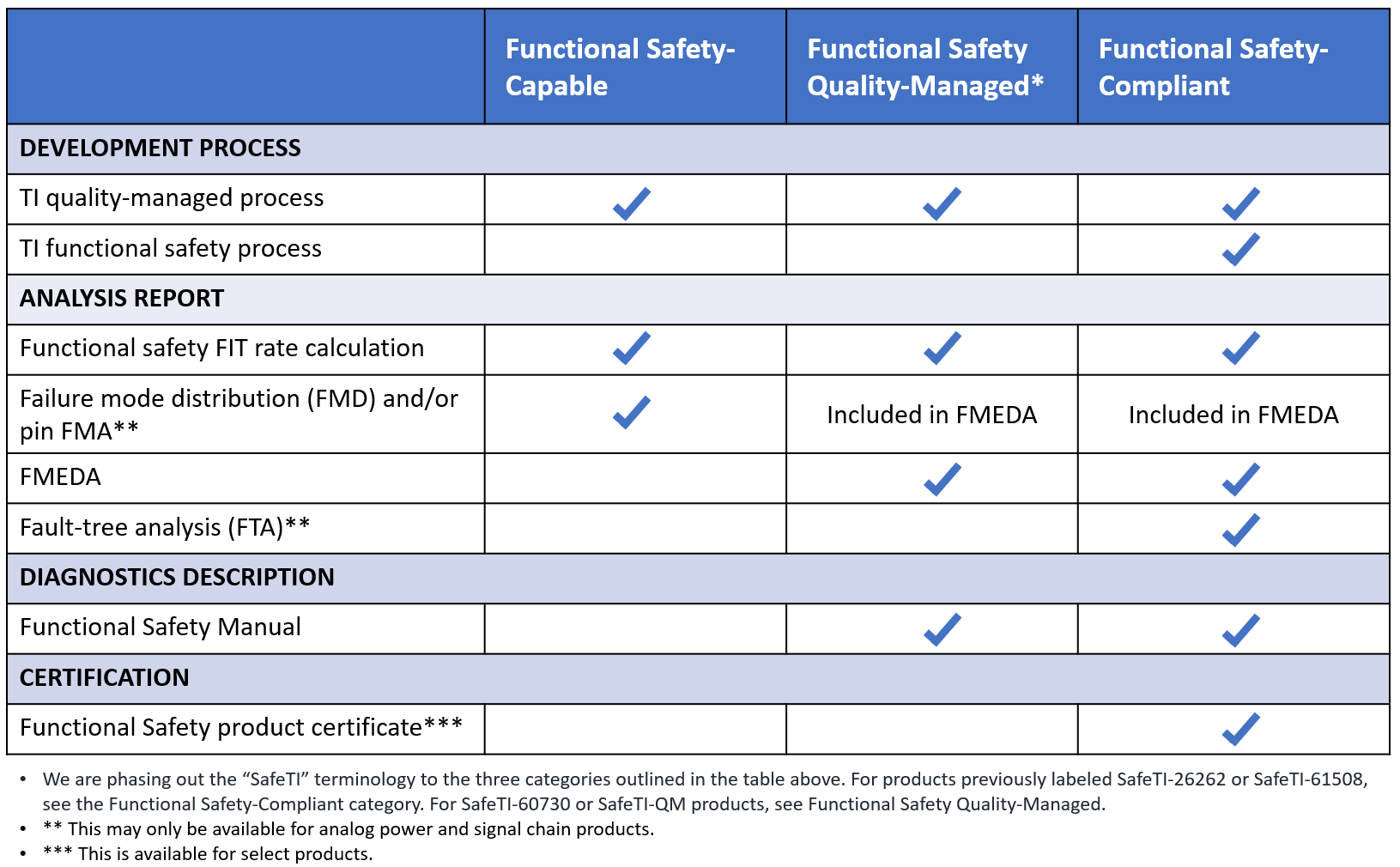SWRU598A June 2022 – April 2024 AWR1243 , AWR1642 , AWR1843 , AWR2243 , AWR2944 , AWR6443 , AWR6843 , AWRL1432 , AWRL6432 , IWR6843
1 Introduction
Functional safety(FuSa) refers to the absence of unreasonable risk due to hazards caused by the malfunctioning behavior of electrical/electronic components in the systems (Ex: Anti-lock Braking systems, Elevators, Gesture Recognition, Intrusion Detection, Intelligent Robot sensing systems, Kick to open, Corner radar, Front Radar of Automotives, etc.). The objective of the functional safety in systems/subsystems is to minimize the risk associated with dangerous failures in causing physical injury to people or damage to the environment or property. TI addresses functional safety as an integral part of mmWave Radar Sensors.
For designing any FuSa compliant Radar sensor system, TI mmWave Radar sensors are a great choice because of their programmable versatility and the FuSa capabilities. TI mmWave Radar sensors assist vision sensing challenges in automotive and industrial applications which can withstand harsh environmental conditions. TI mmWave Radar sensor feature quick and reliable 3D presence detection and minimize possible collisions by lowering system/machine downtime. TI mmWave Radar sensors can be used for low power accurate motion detection to high-end imaging radar. As the automotive and industrial markets become more autonomous, they face an increasing need to meet stricter FuSa standards. TI mmWave Radar sensors are architected and designed using FuSa certified processes in compliance with the ISO 26262 and IEC 61508 safety standards for the Automotive and Industrial domain, respectively. To the world headed towards autonomy of systems, sensing the targets is vital for detection. Especially for FuSa compliant system, mmWave Radar sensor should detect only true positive targets where TI mmWave Radar sensors can play a crucial role in giving better and more reliable results to aid decisions on the range, velocity and angle of the target with good resolutions.
 Figure 1-1 TI FuSa development processes
Figure 1-1 TI FuSa development processesTI mmWave Radar sensors are developed using FuSa certified processes mentioned in the TI FuSa development processes as Safety Element out of Context(SEooC) with assumptions of application while deriving safety goals per IEC 61508 and ISO 26262 levels. TI mmWave Radar sensors are supported by FuSa compliance device certification from a third party certifier Technischer Überwachungsverein(TÜV). These certifications helps customers achieve safety goals of targeted applications quickly. TI mmWave Radar sensors can be used in applications where functional safety is critical such as in Automated Guided Vehicles, Industrial Robots, etc. All the TI automotive mmWave Radar sensor products are qualified for the AEC-Q100 standard that is accepted widely by the automotive industry for failure mechanism based stress test qualification in Integrated Circuits. Few TI mmWave Radar sensors have special features like low power mode operation; antenna on package; device security with edge intelligence.
Based on the safety standards ISO 26262 and IEC 61508, hardware element classes approximately map to TI's functional safety product categories as Functional Safety Capable, Functional Safety Quality Managed and Functional Safety Compliant. For more details on functional safety classifications after referring to the following Figure 1-2, visit this link.
 Figure 1-2 TI Functional Safety
Classification
Figure 1-2 TI Functional Safety
ClassificationIn this document, we will discuss developing a Radar sensor system design for FuSa certification using the TI mmWave Radar sensors. This document details a typical design life cycle of a functional safety compliant system that can help customers design a FuSa compliant Radar sensor system based on their targeted end system requirements. To develop any FuSa compliant system, the customer could follow the Verification and Validation(V&V) life cycle processes(as per IEEE Standard 1012-2016) in parallel to the proposed design life cycle. The V&V processes checks the system development process and ensures the integrated system accomplishes end equipment requirements by performing various tasks and activities(Requirement Evaluation, Hazard Analysis, Security Analysis, Risk Analysis, Criticality Analysis, etc.) on the system. For better understanding, we will be referring to examples like corner radar of a car based on TI's AWR2944 mmWave Radar sensor and intelligent robot sensing system for safer human presence detection based on IWRL6432 mmWave Radar sensor through out the proposed design life cycle to prepare the system design for FuSa certification as per applicable FuSa standards.
- The safety integrity levels for Automotive applications are ASIL-A/B/C/D as per ISO 26262 standard with ASIL-D being the most stringent. Similarly, for Industrial applications as per IEC 61508 standard safety integrity levels are SIL-1/2/3/4 with SIL-4 being the most stringent.